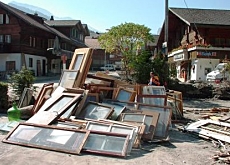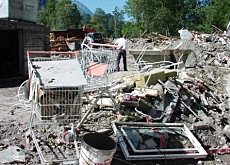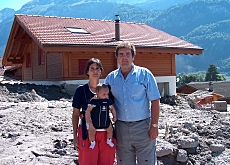Village digs out one month after flood

Even though a month has passed since floods wreaked havoc across Switzerland, the clean-up operation is far from over.
swissinfo took stock of the situation in Oey, a village in the Bernese Alps devastated by the natural disaster.
A steady stream of military vehicles and heavy trucks rumble up and down the road, sending swirls of dust into the air.
My first impression is of a village ravaged by war, and not one that has done battle – and lost – with the forces of nature.
The army vehicles have been commandeered by units of the civil protection service helping in the cleanup, and the trucks are carting away tons of debris.
There are still many mountains of rubble lining the road, and behind the shell of a building that was a pizzeria before last month’s catastrophic events are the twisted remains of several caravans.
“You can see how much damage was done to the houses and shops now that the rubble has been removed from the streets,” Beat Klossner, member of the regional council, tells me, looking down the house-lined road.
Many of the buildings are visibly scarred, having had their water-damaged facades stripped off, and in a few cases, their interior floorboards removed.
“Some of the buildings will have to be completely reconstructed,” Klossner says.
Raging torrent
After four days of torrential rain, the idyllic mountain stream flowing through Oey turned into a raging torrent, spilling its banks and flooding the village.
“It all happened within a quarter of an hour on the Monday morning [August 22] so we had to get out as fast as we could,” remembers Fritz Stähli, owner of a small distillery.
As he directs the cleanup operation on his property, Stähli describes how the railway embankment edging his land acted as a dam, causing the floodwaters to rise 1.5 metres.
Stähli was one of about 200 residents – nearly half of Oey’s population – to evacuate.
When the water receded a few days later, they began returning, no longer recognising the place they called home. Large parts had been buried up to the windows in a thick layer of mud and rubble.
Four weeks on, power has largely been restored but few businesses have reopened. Some are in the process of setting up shop in portable containers, while others have had to move their operations – temporarily – to nearby towns.
It will be weeks before the railway tracks, washed out by the flood, are repaired, and the main road link to the communities in the mountainous hinterland will not be reopened before the end of November.
The authorities have erected an information tent at the village entrance where people have posted notices, giving away second-hand furniture and clothes to those who lost everything.
Psychological aid
Psychological aid is on offer for children and youth traumatised by events, as are foot massages, described in the posting as being “also good for the soul”.
“People have become a little more aggressive in their behaviour, probably because of the stress,” says Irene Stucki of the village bakery. Her business suffered little damage, and used a generator to keep its ovens working even during the worst days of the flooding.
“We have to decide what needs to be cleaned up and what needs to be disposed,” explains Franz Hiltbrand, who has taken over the responsibility for the massive operation underway on his brother’s property, a restaurant and campground.
“We have to dispose of about 4,500 cubic metres of scrap from the damaged buildings and caravans,” he says, “and 3,000 cubic metres of rubble.”
Hiltbrand says the restaurant was insured but not the campground, and the challenge is finding the least expensive place to dispose of the detritus deposited there by the river.
A recycling company has been hired to remove the scrap metal and wood, but no solution has yet been found for the large mounds of earth. He says conventional disposal at a dump would cost at least SFr250,000 ($195,672).
Klossner reckons the total cost of the damage to the village and road repairs at over SFr100 million.
“It will be at least the springtime before life returns to normal here,” he says.
swissinfo, Dale Bechtel in Oey
The flooding and landslides that began the week of August 22 caused damage estimated nationwide at up to SFr2 billion.
Hardest hit were canton Bern and the cantons of central Switzerland.
Nearly half of the population of the village of Oey in the Bernese Alps had to be evacuated.
Local officials say it will be spring of 2006 before normality returns to the village.

In compliance with the JTI standards
More: SWI swissinfo.ch certified by the Journalism Trust Initiative



You can find an overview of ongoing debates with our journalists here. Please join us!
If you want to start a conversation about a topic raised in this article or want to report factual errors, email us at english@swissinfo.ch.